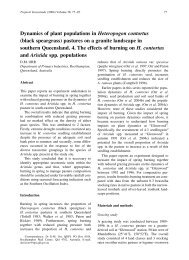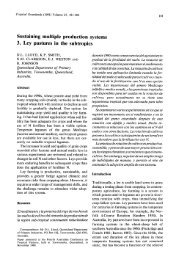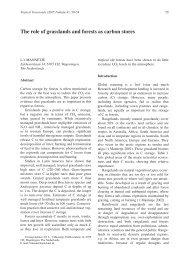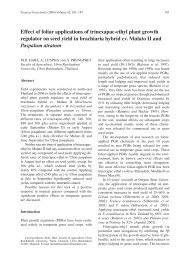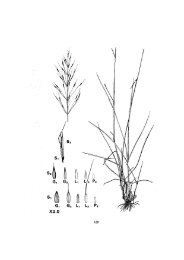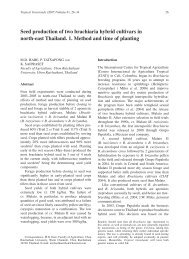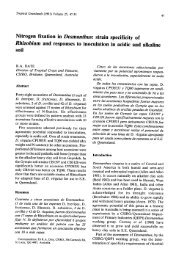Responsible use of exotic tropical pasture cultivars â an ecological ...
Responsible use of exotic tropical pasture cultivars â an ecological ...
Responsible use of exotic tropical pasture cultivars â an ecological ...
You also want an ePaper? Increase the reach of your titles
YUMPU automatically turns print PDFs into web optimized ePapers that Google loves.
336 J.G. McIvor <strong>an</strong>d S. McIntyre<br />
Opportunities for developing <strong>cultivars</strong> <strong>of</strong><br />
native grasses <strong>an</strong>d legumes<br />
Australia has a wide diversity <strong>of</strong> native<br />
herbaceous pl<strong>an</strong>ts but, in contrast with the large<br />
efforts expended on <strong>exotic</strong> <strong>pasture</strong> species, there<br />
have been only limited efforts to develop<br />
<strong>cultivars</strong> from native species (Waters et al. 1997).<br />
A number <strong>of</strong> grasses (e.g. D<strong>an</strong>thonia, Themeda,<br />
Astrebla, Microlaena, Elymus) have been studied<br />
in southern Australia <strong>an</strong>d the native legume<br />
Glycine latifolia is on pre-release in Queensl<strong>an</strong>d.<br />
Very high expectations have been held for<br />
<strong>exotic</strong> pl<strong>an</strong>ts to alleviate production constraints<br />
where native pl<strong>an</strong>ts have been considered<br />
inadequate. In some cases, these expectations<br />
have been too high. As noted earlier, no pl<strong>an</strong>t<br />
strategies have evolved for sites with high levels<br />
<strong>of</strong> both stress (droughted, infertile soils) <strong>an</strong>d disturb<strong>an</strong>ce<br />
(high grazing pressure). The <strong>exotic</strong><br />
“magic bullet” is not <strong>ecological</strong>ly obtainable for<br />
these sites <strong>an</strong>d a ch<strong>an</strong>ge in m<strong>an</strong>agement to lower<br />
the stress <strong>an</strong>d/or disturb<strong>an</strong>ce levels is the only<br />
solution.<br />
Development <strong>of</strong> <strong>cultivars</strong> in the future will<br />
involve new selection criteria <strong>an</strong>d it will not be<br />
possible to focus on single traits to the exclusion<br />
<strong>of</strong> other considerations. Trade-<strong>of</strong>fs will be<br />
necessary <strong>an</strong>d in this consideration, native<br />
species have a number <strong>of</strong> adv<strong>an</strong>tages:<br />
• They have the necessary climatic <strong>an</strong>d edaphic<br />
adaptation, but suitable sowing methods <strong>an</strong>d<br />
m<strong>an</strong>agement regimes for their persistence<br />
need to be determined.<br />
• There are no recognised adverse environmental<br />
impacts <strong>of</strong> native herbaceous species.<br />
• Differences in growth <strong>an</strong>d quality between<br />
species are frequently less th<strong>an</strong> the differences<br />
due to environmental variation, <strong>an</strong>d when<br />
native <strong>an</strong>d <strong>exotic</strong> species are compared under<br />
similar conditions, differences are <strong>of</strong>ten small.<br />
• There are native species with moderate<br />
productivity <strong>an</strong>d grazing toler<strong>an</strong>ce (e.g.<br />
Heteropogon contortus, Bothriochloa <strong>an</strong>d<br />
Dich<strong>an</strong>thium species). These could form the<br />
basis <strong>of</strong> low-input systems which may not be<br />
as productive as high-input systems, but may<br />
have lower risks <strong>of</strong> failure.<br />
However, just as developing <strong>cultivars</strong> from<br />
<strong>exotic</strong> species is a long process, developing <strong>cultivars</strong><br />
from native species will also take a long<br />
time <strong>an</strong>d will require a subst<strong>an</strong>tial effort over<br />
m<strong>an</strong>y years.<br />
Conclusions<br />
Those actions which constitute responsible <strong>use</strong><br />
will depend on the value systems <strong>of</strong> the judge<br />
<strong>an</strong>d different judges will come to different conclusions.<br />
However, in future, the potential<br />
environmental impacts will need to be considered<br />
as well as agronomic perform<strong>an</strong>ce <strong>an</strong>d economic<br />
benefits. The continuing <strong>use</strong> <strong>of</strong> sown <strong>pasture</strong>s<br />
will be a bal<strong>an</strong>cing act <strong>an</strong>d it is essential that<br />
environmental issues are considered. There are<br />
opportunities to develop new <strong>cultivars</strong>, both<br />
<strong>exotic</strong> <strong>an</strong>d native, <strong>an</strong>d also to develop m<strong>an</strong>agement<br />
systems for them. This will involve trade<strong>of</strong>fs<br />
<strong>an</strong>d sacrifices <strong>an</strong>d there will always be some<br />
risk, but this c<strong>an</strong> be minimised so that their<br />
benefits c<strong>an</strong> be captured <strong>an</strong>d unw<strong>an</strong>ted environmental<br />
effects prevented.<br />
References<br />
CAMPBELL, B.D. (1990) Pasture <strong>cultivars</strong> in <strong>ecological</strong><br />
perspective. Proceedings <strong>of</strong> the New Zeal<strong>an</strong>d Grassl<strong>an</strong>d<br />
Association, 51, 139–142.<br />
CLEMENTS, R.J. (1996) Pastures for prosperity. 3. The future<br />
for new <strong>tropical</strong> <strong>pasture</strong> species. Tropical Grassl<strong>an</strong>ds, 30,<br />
31–46.<br />
DAVIES, J.G. <strong>an</strong>d EYLES, A.G. (1965) Exp<strong>an</strong>sion <strong>of</strong> Australi<strong>an</strong><br />
pastoral production. Journal <strong>of</strong> the Australi<strong>an</strong> Institute <strong>of</strong><br />
Agricultural Science, 31, 77–93.<br />
EBERSOHN, J.P. <strong>an</strong>d LEE, G.R. (1972) The impact <strong>of</strong> sown<br />
<strong>pasture</strong>s on cattle numbers in Queensl<strong>an</strong>d. Australi<strong>an</strong><br />
Veterinary Journal, 48, 217–223.<br />
GRIME, J.P. (1977) Evidence for the existence <strong>of</strong> three primary<br />
strategies in pl<strong>an</strong>ts <strong>an</strong>d its relev<strong>an</strong>ce to <strong>ecological</strong> <strong>an</strong>d<br />
evolutionary theory. Americ<strong>an</strong> Naturalist, 111, 1169–1194.<br />
GRIME, J.P. (1979) Pl<strong>an</strong>t Strategies <strong>an</strong>d Vegetation Processes.<br />
(John Wiley <strong>an</strong>d Sons: New York).<br />
GRIME, J.P. (1988) The C-S-R model <strong>of</strong> primary pl<strong>an</strong>t<br />
strategies — origins, implications <strong>an</strong>d tests. In: Gottlieb,<br />
L.D. <strong>an</strong>d Jain, S.K. (eds) Pl<strong>an</strong>t Evolutionary Biology.<br />
pp. 371–393. (Chapm<strong>an</strong> Hall: London).<br />
HACKER, J.B. (1997) Priorities <strong>an</strong>d activities <strong>of</strong> the Australi<strong>an</strong><br />
Tropical Forages Genetic Resource Centre. Tropical Grassl<strong>an</strong>ds,<br />
31, 243–250.<br />
HUMPHRIES, S.E., GROVES, R.H. <strong>an</strong>d MITCHELL, D.S. (1991)<br />
Pl<strong>an</strong>t invasions: The incidence <strong>of</strong> environmental weeds in<br />
Australia. Kowari, 2, 1–134.<br />
LONSDALE, W.M. (1994) Inviting trouble: Introduced <strong>pasture</strong><br />
species in northern Australia. Australi<strong>an</strong> Journal <strong>of</strong> Ecology,<br />
19, 345–354.<br />
MCIVOR, J.G. <strong>an</strong>d GARDENER, C.J. (1995) Pasture m<strong>an</strong>agement<br />
in semi-arid <strong>tropical</strong> woodl<strong>an</strong>ds: effects on herbage<br />
yields <strong>an</strong>d bot<strong>an</strong>ical composition. Australi<strong>an</strong> Journal <strong>of</strong><br />
Experimental Agriculture, 35, 705–715.<br />
WALKER, B. <strong>an</strong>d WESTON, E.J. (1990) Pasture development in<br />
Queensl<strong>an</strong>d — A success story. Tropical Grassl<strong>an</strong>ds, 24,<br />
257–268.<br />
WATERS, C.M., LOCH, D.S. <strong>an</strong>d JOHNSTON, P.W. (1997) The<br />
role <strong>of</strong> native grasses <strong>an</strong>d legumes for l<strong>an</strong>d revegetation in<br />
central <strong>an</strong>d eastern Australia with particular reference to low<br />
rainfall areas. Tropical Grassl<strong>an</strong>ds, 31, 304–310.<br />
WESTON, E.J., HARBISON, J., LESLIE, J.K., ROSENTHAL, K.M.<br />
<strong>an</strong>d MAYER, R.J. (1981) Assessment <strong>of</strong> the agricultural <strong>an</strong>d<br />
pastoral potential <strong>of</strong> Queensl<strong>an</strong>d. Technical Report No. 27,<br />
Agriculture Br<strong>an</strong>ch, Queensl<strong>an</strong>d Department <strong>of</strong> Primary<br />
Industries, Brisb<strong>an</strong>e.



